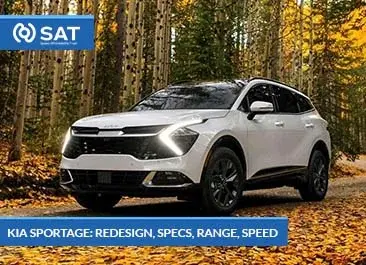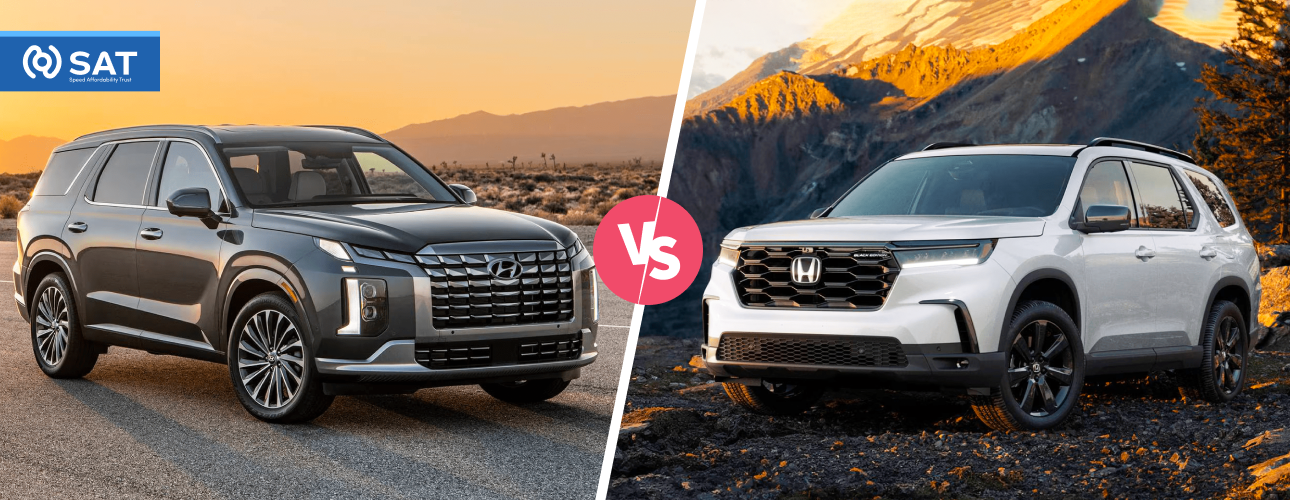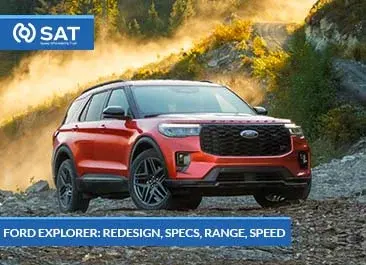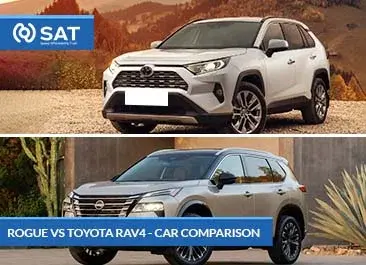Two of the poshest midsize SUVs out there, the Hyundai Palisade and the Honda Pilot come loaded with everything from family-sized space to improved safety, all the way to leading-edge technology. But which do you want?
Let’s dive into a detailed comparison of these two midsize SUVs in order to help you make the best decision. We’ll differentiate it into four key areas: design, performance, safety, technology, and overall value.
Exterior Design: Bold vs. Classic
The exterior design of any vehicle is going to be the first impression that one gets from a car. Both the Hyundai Palisade and Honda Pilot can be termed as stylish, although these two are so different in appearance that they will appeal to different tastes.
Hyundai Palisade Design
It boasts its bold and modern styling. The large front grille, along with sharp LED headlamps, gives it such a commanding road presence. Along with this sporty detailing in the grille, it boasts a wide stance; thus, confidence is exuded.
- Luxurious Details Outside: Advanced chrome exhaust tips and higher-quality trim finish the exterior with a premium feel, but on lesser trims, exterior parts give it an appearance of something much more luxurious.
- Wheels: The Palisade provides numerous options for wheels. There are standard 18-inches and a bolder 20-inch alloy offered on more advanced trims that exude sheer functionality but add stylish appeal.
- Light: The Palisade also employs full LED headlights and taillights that help to give this car a smooth, futuristic look. High trims also include special “Hyundai badging lights” wherein the logo itself lights up.
- Color Options: The Palisade comes in very bold colors such as the Steel Graphite, Moonlight Cloud, Sierra Burgundy, and Hyper White. All such colors can be provided by the Palisade so that every owner of the car can customize it according to his character.
Honda Pilot Design
- Classic and Simple Design: The Honda Pilot is conservative with a more classic look of an SUV. It does not boast of a bold, in-your-face design compared to its newer cousin, Palisade; however, people do get drawn to it for its traditional rugged look.
- Functional Styling: The Pilot is fully aware that it cannot, by any stretch of the imagination, win any prizes for style, but it can take a more practical if not less pretty, approach; roof rails and skid plates serve to underpin its nature. It’s family-friendly, thanks to large doors and access to the cabin.
- Wheel Options: Much like the Palisade, the Pilot has a variety of wheels. There is an 18-inch one for the lower trims and a 20-inch one for the high trims like the Elite. That makes it trim as sporty.
- Lighting: When it comes to the LED headlamps and fog lamps, the lighting system of the Pilot is much more basic and functional than its competitor’s styled package.
- Color Options: The Honda Pilot is available in some fantastic colors, which vary from chic Obsidian Blue Pearl to Platinum White Pearl, and adventurous Sonic Gray Pearl and Radiant Red Metallic.
Judgment on Exteriors:
If you’re looking for something sleek and eye-catching in design, then Hyundai Palisade is taking the gold for smoothness, classiness, and modernic. But if what you want is to have that subtle yet classy look of an SUV with lots of useful features intact, then Honda Pilot will do just fine.
Interior and Comfort: Luxury and Practicality
From an interior viewpoint, the Hyundai Palisade and Honda Pilot might appear to be roomy and supportive cabins, but the former nudges a premium feel more than the latter, which is a bit more practical.
Hyundai Palisade Interior
- Luxury Cabin: The cabin feels much more luxurious than you would find in a midsize luxury car. For starters, the cabin is trimmed with soft-touch materials, the seats of higher trims are good quality leather, and round the cabin gives off a high level of ambient lighting that adds to the opulent feel. Another sleek and modern thing about the design of the dashboard is that there’s no button for minimalistic thinking and instead features one big central touchscreen.
- Seating Comfort: The Palisade promises comfort using Nappa leather seats. They’re plush and supportive and made for long road journeys. Better trims have ventilated power-adjustable seats for the front, and the second row will feature seat options that may be captain’s chairs to offer more comfort options.
- Cargo Space: There is ample cargo space behind the third row at 18 cubic feet, behind the second row at 45.8 cubic feet, and a maximum of 86.4 cubic feet when both rows are folded completely to a flat surface. Further, there are secretive storage spaces where valuables can be placed for safe hiding.
- Accessibility Third Row: The Palisade has one-touch sliding second-row seats, so it’s easier to access the third row. This comes in handy for families where kids are usually hauled around.
There are also luxurious touches, such as quilted leather door panels, the headliner on the Calligraphy trim is made of microfiber suede, and the perforated leather steering wheel.
Honda Pilot Interior
- Cozy, family-friendly cabin: The Pilot’s interior is practical and family-friendly. Not as luxurious as the Palisade, it’s roomy and extremely functional-with space for up to eight passengers (or seven with an optional second-row captain’s chairs).
- Seating Comfort: This is one area in which the Pilot delivers rather well, particularly in the upper trims. It is roomy and supportively comfortable, even for long drives, though the materials on it are a tad more utility-minded than the premium finishes on the Palisade.
- Cargo Area: The Pilot offers a little more cargo area than the Palisade, behind third-row seats 16.5 cu. ft., behind the second row, 46.8 cu. ft. and up to 83.9 cu. ft. with all the seats folded down. The Pilot also features a reversible cargo lid that provides added flexibility to carry forms of cargo.
- Third Row Access: For those who do need to push past a little bit of awkwardness to access the third row, the Pilot does offer that feature, but getting to that third row is only slightly more awkward than it is in the Palisade. Once you’re buckled in, though, third-row legroom is as sufficient as that of a midsize SUV.
- Practical Features: There are plenty of practical storage abounds in the Pilot’s cabin, from multiple cup holders and door pockets to under-seat storage. Even a conversation mirror can be built in to help parents see what their rear-seat riders are up to.
Interior and Comfort Verdict
So, if you care about luxury, premium finishes, and high-end design, then the Hyundai Palisade would be, hands down the winner because of its rich material and an amplitude of high-end features. However, when you are one who finds a spacious, practical cabin with versatile seating accommodating larger families with comfort and convenience to be a lot crucial in your purchase, then the Honda Pilot would just do fine.
Technology and Infotainment: A Comparison
Hyundai Palisade comes with many more technologically geared features than Honda Pilot, but it is somewhat short in terms of updated modern cutting-edge technology and luxury products. I can at least try to make you a list of some tech-related features that both the Hyundai Palisade and Honda Pilot come with.
- Infotainment System: The inbuilt 8-inch screen infotainment system is the same as the 12.3-inch digital instrument cluster, which may even be a 10.25-inch one, too. Of course, this infotainment system is pretty neat and user-friendly with clear graphics. The system comes as a standard with Apple CarPlay and Android Auto and even connectivity with the help of Bluetooth.
- Higher Trims: The higher trims of the lineup sports a 12-speaker Harman Kardon premium audio system, whose crystal clarity in the sound leaves no room for speculation. The detailing in the design of the audio system is the kind to sing to an audiophile.
- Navigation and Display: On the largest trims of the Palisade, a navigation system is standard. The 10.25-inch touchscreen display accepts split-screen functionality; this means drivers may easily control the car while simultaneously controlling the music.
- Head-Up Display: A head-up display is standard on higher trims, projecting key driving information- such as the speed and navigating directly onto the windshield so the driver doesn’t have to leave the road.
- Wireless Charging: Upper trims get a wireless charging pad where you simply place your smartphone to charge it. There is a thoughtful placement of the charging pad in the center console, making it available to everyone.
Honda Pilot Technology
Infotainment System. All Pilots have it; this 8-inch touchscreen-based infotainment system. That infotainment system has Apple CarPlay and Android Auto built in, but the interface isn’t nearly as seamless as the Palisade’s is, though it’s functional.
- Audio System: In the lower trims, the Pilot features 7 speakers and in higher trims, a 10-speaker premium audio. That certainly sounds nice but isn’t nearly produced to be as close to premium as in the Harman Kardon equipped version of the Palisade.
- Navigation: The equivalent on higher trims is optional. The screen graphics and response time cannot compare to the fluid ones on the Palisade. The feature known as split-screen capability is also missing.
- Entertainment System: The Pilot’s rear-seat entertainment system, a high point for the optional, is this tenacious beast. This one features a ten-point-two-inch screen equipped with a Blu-ray player and HDMI ports for uninterrupted hours of kid-friendly fun in the car on long drives.
- Cabin Talk: One of the features that establish comfort for your family members is CabinTalk. So a driver can talk to passengers on the audio system or headphones, but still keep the communication sound at all times.
Overall Verdict on Technology and Infotainment:
Key features of Hyundai Palisade are large high-definition digital screens, premium advanced audio, and a head-up display. Hence, the Palisade is the best choice for those who will be looking for a classy modern vehicle. The Honda Pilot caters to family requirements, as you get a rear entertainment system and other genuinely practical features such as CabinTalk.
Safety Features: Advanced Safety Features to Have a Safe Road Experience
Other safety features are similar as well between the Hyundai Palisade and Honda Pilot.
Hyundai Palisade Safety
- Smart Sense: Hyundai SmartSense is actually the safety suite’s topping version of the Palisade. It is designed for safety since it encompasses several functions including the forward collision-avoidance assist, blind-spot collision-avoidance assist, rear cross-traffic collision-avoidance assist, and a lane-keeping assistant with adaptive cruise control that supports stop-and-go functionality.
- Highway Drive Assist Highway: Drive Assist is effectively an adaptation of adaptive cruise control combined with other provisions for lane-centering assistance supporting partially autonomous highway driving. Therefore, drivers can relax a little more on long journeys.
- Safe Exit Assist: It also warns the occupants that some car is approaching them from the rear side while somebody is about to exit from that door, thus rescuing them from such accidents. Really good for families having children.
- Surround View Monitor: The Palisade comes paired with a 360-degree surround-view camera that, through a bird’s eye view of the vehicle during parking and low-speed operation, makes even the most testing parking spaces much easier to access.
Honda Pilot Safety
- Honda Sensing: As if all this wasn’t enough, pilot also features Honda Sensing, which basically is an in-built suite of safety features much like Hyundai’s SmartSense. These so far include forward collision warning, a collision mitigation braking system, lane-keeping assistance, road departure mitigation, and adaptive cruise control.
- Blind Spot Monitoring: adds a trim-to-trim feature; blind-spot monitoring with cross-traffic alert is offered. Lower trims lack it.
- Multi-Angle Rearview Camera: It is fitted with a wide-angle, top-down, and normal rearview camera to help the driver drive out of tight spaces when reversing.
- Cross-traffic Monitor: This feature is found only in higher trims. As you back out of any parking space, this feature will alert you to approaching vehicles, helping prevent accidents.
- Safety Verdict: Both provide comprehensive safety toolkits, but while the Hyundai Palisade adds extra family protection with Highway Drive Assist and Safe Exit Assist, the Honda Pilot is not slouching instead, offering safer features only in upper trims.
Performance and Powertrain: Smooth Ride vs. Rugged Capability
Both Hyundai Palisade and Honda Pilot can give good output, but the situation in relation to taste and preference is different in both according to the provision of power and dynamics on road.
Hyundai Palisade Performance
- Engine: Hyundai Palisade takes along with it a 3.8-liter V6, which churns 291 horses and 262 lb-ft of torque. It comes paired with an 8-speed automatic transmission that shifts smoothly without much fuss and offers satisfactory response time.
- Suspension: The ride for the Palisade is very smooth and comfortable, being very refined. Its suspension is tuned to a very low degree in order to make it very agile and fluid in traversing imperfections on the road.
- All-Wheel Drive: All-wheel drive is an option for the Palisade. This further improves traction in several road conditions. It also serves as a great option for people who stay in areas receiving snowy or slippery conditions.
- Drive Modes: The Palisade offers comfort, sport, eco, and snow drive modes. Drivers can fine-tune driving conditions to how they want to drive or to changing road conditions.
Honda Pilot Performance
- Powertrain: The Pilot employs the same 3.5-liter V6 good for 280 hp and 262 lb-ft of torque, but in the Pilot it’s mated to a 9-speed automatic transmission that shifts just a little snappier than in the Palisade.
- Underway: The Pilot has a much more aggressive and stiffer suspension setup, which is really good at absorbing nasty road traversal much better with lot less drama than the Palisade. It is perfect for adventure-loving men.
- Available All-Wheel Drive: And the Pilot has available all-wheel drive, too, and Honda’s Intelligent Variable Torque Management system, which helps improve traction and vehicle handling even in slippery roads or off-road trails.
- Drive Modes: The Pilot has drive modes like Normal, Snow, Mud, and Sand in its vehicle to make it more versatile for a variety of off-road excursions.
- Verdict on Performance: If it’s a hassle-free ride to yourself daily to commute around or long drives, the Hyundai Palisade is ready for you. If it’s a tough capability that you’d love to take your SUV off-road or through rough terrain, the Honda Pilot might be more suitable.
- Fuel Economy: This is one of the main priorities for most SUV shoppers, given the rising fuel prices that seem to not have a chance to level off anytime soon. Both Hyundai Palisade and Honda Pilot do well when it comes to fuel economy for their size and class.
Hyundai Palisade Fuel Economy
- EPA Ratings: Front-wheel-drive configuration comes in at 19 city, 26 highway, and 22 combined. The all-wheel-drive models fall back just a small little bit: 19 city, 24 highway, and 21 combined.
- Fuel Capacity: The Palisade holds an 18.8-gallon fuel tank and can provide satisfactory miles for road trips, mainly with the FWD variant.
Honda Pilot Fuel Economy
Honda Pilot EPA ratings are also in the same class–it is rated 20 MPG on city roads, 27 MPG on highways, and 23 MPG on combined routes for the front-wheel drive version. It does go down to 19 MPG on city roads, 26 MPG on highways, and 22 MPG on combined routes for the all-wheel-drive version.
- Fuel Tank: The Pilot comes with a 19.5-gallon fuel tank, and this makes it marginally longer to rival that of Palisade. This will be a good feature for those who run very long highway stretches or regular long commutes.
Final Remarks About the Fuel Efficiency:
The fuel economies of the two models are nearly the same, with Honda Pilot edging out Palisade because it has marginally better mileage combined with a larger tank size.
Price and Trim Value for Money
We shall look at the pricing and trim options for the Hyundai Palisade and the Honda Pilot. The latter offers more trims in different price ranges but is indeed a luxury type and a little more expensive.
Hyundai Palisade Price
- SE (Base Model): The SE starts just above $35,500. At this end, you have listed as standard an 8-inch touchscreen, Apple CarPlay, Android Auto, and Hyundai SmartSense features.
- SEL: The SEL will run you around $38,500. This comes with a package of premium amenities, which includes heated front seats and a power liftgate, plus second-row captain’s chairs.
- Limited: This will be priced at around $46,000. It includes Nappa leather seating, a dual-panel sunroof, and 10.25-inch touchscreen features that add navigation as well.
- Calligraphy (Top Trim): A variant that carries a base price of $48,500, Pilot Calligraphy comes with quilted Nappa leather, a headliner of microfiber suede, and 20 wheels
Honda Pilot Prices
- LX (Lowest-Trimmed Model): For a base price estimate of nearly $37,000, the base model LX is a great deal, the Honda Sensing suite of safety features, a 5-inch infotainment display, and up to eight-person seating.
- EX-L: EX-L starts around $40,500 with Leather Seating and Power Rear Liftgate, and then comes with the 8-inch touchscreen interface with Apple CarPlay and Android Auto.
- Touring: Touring will start at about $45,500 for this model that comes with a rear-seat entertainment system, hands-free power tailgate, and premium audio.
- Elite (Top Trim): The Elite begins at $50,000 with All-wheel drive, Panoramic roof, ventilated front seats, and wireless phone charging.
Price and Trims Verdict
Hyundai Palisade offers more premium features at slightly less expensive rates than Honda Pilot. The Pilot, however, has more trim options that cater to most budgets and preferences.
Which SUV Should You Choose?
While the Hyundai Palisade and Honda Pilot are both top-of-the-line midsize SUVs, they are designed to meet a very different kind of buyer. The Hyundai Palisade is thought for someone who thinks in terms of high luxury, latest technology, and comfort of the ride. But if you need something that can be used as a family-friendly rugged off-roader, loaded with practical features and off-road capability, then the better option for you would be the Honda Pilot. Click here for more information about SAT Japan.
Ultimately, it’s entirely up to your needs – premium-feeling SUV for a healthy dose of city driving or versatile car ready for adventure anytime you need to carry the kids out on that family road trip!




